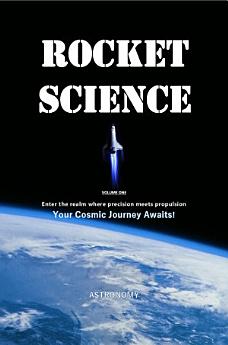Rocket Science
About this ebook
From the earliest ideas of propulsion to the highly advanced systems used today, rocket technology has advanced through centuries of trial, discovery, and innovation. This book traces that journey in a structured and focused way. It explains how rockets are built, how they generate thrust, and how they are guided across vast distances with precision.
Rather than simply listing facts, this book aims to connect ideas. Concepts are presented step by step, with simple language and visual thinking. Technical terms are used only when necessary, and formulas are introduced with purpose. When numbers appear, they serve to explain, not overwhelm.
This is not a textbook, and it is not a collection of trivia. It is a guide for readers who want to understand the machinery and thinking behind spaceflight. Whether you are just beginning or have studied the subject before, you will find material here that builds knowledge in a clear and logical way.
Rocket Science is for learners, explorers, and thinkers. It is for those who value clarity and want to see how raw physical forces can be shaped into controlled motion. It is for readers who understand that getting a rocket off the ground is not magic, but method.
Let us begin, step by step, with the fundamentals that carry us beyond the surface of our world.
Let’s explore the universe together.
About the author
How I developed an Interest in Astronomy?
As I look up at the night sky, I can’t help but think about the journey that led me to my passion for astronomy. It all started when I was a child, asking endless questions out of pure curiosity. I recall pestering my father with whimsical queries, such as "How long would an ant take to circle the moon?" – A testament to my naivety about the moon's enormity.
The stars had always fascinated me, but one moment stands out. During a power outage, I stepped onto the rooftop and saw the night sky in all its clarity. That view left an impression on me. Around the same time, I found myself drawn to science books, especially the sections that explained the difference between stars and planets. My growing interest even helped me score high in a 1995 geography test that included astronomy questions.
But what truly deepened my love for space was an unexpected experience with virtual reality. While visiting a mall, I tried an Oculus Rift demo called "Deep Space VR." The experience was unlike anything I had ever felt before. As soon as I got home, I searched for similar content on YouTube, and before long, I bought my own VR headset.
As I explored more about space, I came across a YouTube video promoting Flat Earth theories. It was surprisingly convincing at first, and I found myself questioning what I knew. But instead of blindly accepting the claims, I decided to investigate for myself. That’s when I bought my first telescope - Celestron PowerSeeker 50Az. One of the claims, that the moon emits its own light, was disproven when I observed the shadows within moon craters – a phenomenon impossible if the moon were self-luminescent. That moment changed everything. I moved away from pseudoscience and focused on real space exploration. Over the years, I studied astronomy intensely, gathering knowledge and refining my understanding. Eventually, I felt the need to share what I had learned in a way that was easy for others to understand. That’s how the idea of writing a book was born.
Looking back, I realize that curiosity is what led me here. The universe has a way of pulling us in, making us ask questions, and pushing us to explore beyond what we know. And for me, that curiosity turned into a lifelong passion.






